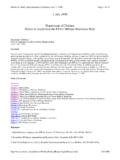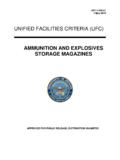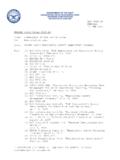Transcription of DDESB Assessing Explosives Safety Risks, …
1 Technical Paper 23 31 July 2009 DDESB Assessing Explosives Safety risks , Deviations, and consequences Department of Defense Explosives Safety Board Alexandria, Virginia Approved for public release; distribution is unlimited. DDESB TP 23 2 REPORT DOCUMENTATION PAGE Form Approved OMB No. 0704-0188 Public reporting burden for this collection of information is estimated to average 1 hour per response, including the time for reviewing instructions, searching existing data sources, gathering and maintaining the data needed, and completing and reviewing this collection of information.
2 Send comments regarding this burden estimate or any other aspect of this collection of information, including suggestions for reducing this burden to Department of Defense, Washington Headquarters Services, Directorate for Information Operations and Reports (0704-0188), 1215 Jefferson Davis Highway, Suite 1204, Arlington, VA 22202-4302. Respondents should be aware that notwithstanding any other provision of law, no person shall be subject to any penalty for failing to comply with a collection of information if it does not display a currently valid OMB control number.
3 PLEASE DO NOT RETURN YOUR FORM TO THE ABOVE ADDRESS. 1. REPORT DATE (DD-MM-YYYY) 2. REPORT TYPE 3. DATES COVERED (From - To) 4. TITLE AND SUBTITLE 5a. CONTRACT NUMBER 5b. GRANT NUMBER 5c. PROGRAM ELEMENT NUMBER 6. AUTHOR(S) 5d. PROJECT NUMBER 5e. TASK NUMBER 5f. WORK UNIT NUMBER 7. PERFORMING ORGANIZATION NAME(S) AND ADDRESS(ES) 8. PERFORMING ORGANIZATION REPORT NUMBER 9. SPONSORING / MONITORING AGENCY NAME(S) AND ADDRESS(ES)10. SPONSOR/MONITOR S ACRONYM(S) 11. SPONSOR/MONITOR S REPORT NUMBER(S) 12. DISTRIBUTION / AVAILABILITY STATEMENT 13.
4 SUPPLEMENTARY NOTES 14. ABSTRACT 15. SUBJECT TERMS 16. SECURITY CLASSIFICATION OF: 17. LIMITATION OF ABSTRACT 18. NUMBER OF PAGES 19a. NAME OF RESPONSIBLE PERSON a. REPORT b. ABSTRACT c. THIS PAGE 19b. TELEPHONE NUMBER (include area code) Standard Form 298 (Rev. 8-98)Prescribed by ANSI Std. DDESB TP 23 4 TABLE OF CONTENTS Page FOREWORD ..3 CHAPTER 1. INTRODUCTION ..6 Background ..6 Objectives ..6 CHAPTER 2. RISK MANAGEMENT MODEL ..7 Office of Management and Budget (OMB) Principles of Risk Management.
5 7 DoD ESRM Process ..10 Army Composite Risk Management (CRM) Process ..11 Navy and Marine Corps ORM Process ..12 Air Force ORM Process ..13 CHAPTER 3. DDESB ESRM PROCESS ..15 General ..15 TRA Steps ..17 Step 1: Identify Step 2: Assess Step 3: Develop Risk Control MRA Steps ..19 Step 1: Make Risk Decisions ..19 Step 2: Implement Selected Options ..20 Step 3: Monitor and Evaluate Mitigation Controls ..20 CHAPTER 4. DEVIATIONS AND HYBRID Safety SUBMISSIONS (HSS)..21 Deviations ..21 HSS.
6 21 CHAPTER 5. AUTOMATED Safety ASSESSMENT PROTOCOL - Explosives ..23 General ..23 Automated Safety Assessment Protocol - Explosives Instructions ..24 REFERENCES ..25 APPENDIX A. AUTOMATED Safety ASSESSMENT PROTOCOL Explosives WORKSHEETS/CALCULATIONS ..26 DDESB TP 23 5 GLOSSARY ..34 TABLE Risk Management Process Comparison ..10 FIGURES OMB General Principles ..8 OMB Principles for Risk ESRM Model ..11 DDESB Dynamic ESRM Model ..16 DDESB TP 23 6 CHAPTER 1 INTRODUCTION Background To better serve the warfighter, the Department of Defense Explosives Safety Board ( DDESB ) is continually transforming, seeking continuous improvement, and operationalizing the DoD s ESMP.
7 This includes the development of new ESMP-related tools and approaches to assist warfighters in executing their mission, conserving resources, and maximizing operational effectiveness. When mission risk is reviewed and managed correctly, Department of Defense (DoD) Components can safely and aggressively execute their missions. This TP: Describes the DDESB Explosives Safety Risk Management (ESRM) Program outlined in DoD Instruction (DoDI) (Reference (a)). Presents a course of action and a tool to standardize the deviation process and information provided for Explosives risk decisions.
8 Provides decision-makers associated with DoD munitions assets worldwide with a more understandable and consolidated information package for their review, with the overall goal to reduce and manage residual risk. Objectives. It is DoD policy to: Provide the maximum possible protection to people and property from the damaging effects of DoD military munitions in accordance with DoD Directive (DoDD) (Reference (b)). Make informed risk decisions at the appropriate level of leadership in accordance with Reference (b) and DoDD (Reference (c)).
9 Implement management system approaches and best business practices to maintain ESMPs in accordance with Reference (c). Provide standardized information for determining and Assessing Explosives Safety risk in accordance with DoD (Reference (d). DDESB TP 23 7 CHAPTER 2 RISK MANAGEMENT MODEL Office of Management and Budget (OMB) Principles of Risk Management In 1995, the OMB prepared a memorandum titled, Principles of Risk Management (Reference (f)). It stated that the principles are aspirational rather than prescriptive.)
10 Their application requires flexibility and practical judgment. The science of risk assessment is rapidly changing and its use is a function of a number of factors including legal mandates and available resources that vary from one regulatory program to another. We therefore do not offer these principles as conclusive, complete or irrevocable; they are intended to be used as a point of departure for future efforts within individual agencies and the Executive Branch broadly. OMB reissued the information in a September 2007 memorandum titled, Updated Principles for Risk Analysis (Reference (g)).






